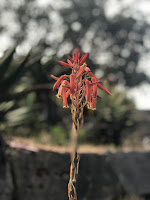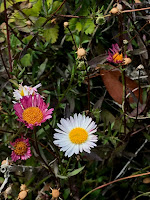Exploring San Francisco's botanical garden
Biboy and Barbara invited Anna and me to go with them to the San Francisco Botanical Garden. Finally, an opportunity for me to go on a walk! Since I moved to California, I've mostly stayed indoors.
I was in San Francisco earlier this year, in winter. This is the first time, in more than 10 years, that I visited the city in summer. And the perfect place to explore was the botanical garden... a few months ago, I was at Singapore Botanic Gardens with my parents so it's cool that I'm doing some sort of a reprise with my siblings.
I am not a green thumb but I am fascinated by botanical gardens because these are like living museums. These parks certainly beat visiting gene banks and herbaria where people only see collections of seeds or dried specimens because visitors can see the actual living plants.
The four of us took this opportunity to walk around and to take photos. Biboy was even lugging around his DSLR.
The botanical garden was charming... there were a lot of pathways that made me imagine being in the flower patch in animated version of Alice in Wonderland. Some paths were paved; some were trails; and some were staircases. All of these paths led to very different gardens, highlighting the diverse collection of plants that can be found in this botanical garden.
Plus, there were a few ponds in the garden. These provided beautiful views... people can sit back, relax and enjoy the scenery. The waterfowl pond was quite empty when we dropped by. I think that the ducks and/or the geese were waddling in the nearby meadow at the time.
We passed by another pond. This one felt more secluded. There were a lot of plants floating on the water, giving this place more of a Secret Garden feel. I liked this spot more because there's a bit more colour... we could see hints of purple and splashes of yellow amid the greens and the blues.
Aside from plants and animals, we also saw some decorative elements that marked the different parts of the garden. For instance, this landmark indicated that we were in the temperate Asia garden.
In the redwood grove, we came up close to these towering coastal redwoods. I've only seen them this close once before, when Ate Maddie and I visited Muir Woods.
At the garden of California native plants, we noticed that there were signs warning us about caterpillars crossing. Apparently, this is the season when caterpillars start finding spots to metamorphose (build their cocoons). I'm not sure if the butterfly species are rare; but still, every butterfly counts in pollination and in ensuring that plants are able to reproduce. We took care not to step onto flower beds and on logs, in case the caterpillars were there. This part of the garden reminded me of the butterfly enclosure in Sentosa with its chrysalis collection and the juvenile butterflies which were waiting for their wings to dry.
The San Francisco Botanical Garden's collection of plants came from different parts of the world. I was amazed that the gardeners could propagate succulents alongside redwoods, South African plants near tropical Asian plants, and Australian plants in close proximity to the South American collection. The garden's website explains that the collection is grouped based on three main climate classifications: montane tropical, Mediterranean, and temperate. The microclimates inside the botanical garden have allowed these plants to thrive in San Francisco.
It's fascinating to see so many flowers blooming in the different parts of the garden. I did miss seeing tulips and roses but it's not much of a big deal because there were so many others present... I don't even know what they are! But they're pretty and looked very friendly.
I'm sure that I'll be back!



















Comments
Post a Comment
Thank you for dropping by!
Before moving on, please share your thoughts or comments about the post. :)
Thanks again!